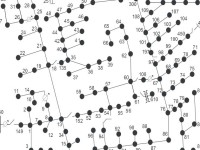The operation of a power network requires accurate monitoring of its state: bus voltages, line currents, consumption, and generation. This is especially relevant in transmission networks where volatile and distributed generation and consumption cause bidirectional power flow and voltage drops. Therefore, State Estimation (SE) [1] is used to estimate the bus voltage phasors using the power flow equations derived from the structure of the network, represented by the admittance matrix. SE is typically performed by taking several measurements and solving a weighted least-squares problem using an iterative approach like Newton-Raphson.
![Figure 1. Structure of a State Estimator [2]](http://www.incite-itn.eu/wp-content/uploads/2018/07/Fig1.jpg)
Figure 1. Structure of a State Estimator [2]
Traditionally, distribution networks used to have a simple radial structure with a single source bus, connected to the main grid at the substation, and injecting power, and consequently, SE was not as necessary as in transmission networks. However, nowadays this is changing given the increasing number of sources of distributed generation like PV-panels, electrical vehicles, batteries, etc. injecting power into the network and causing bidirectional power flow. Consequently, SE becomes necessary in distribution networks. However, there are some problems that make this task specially difficult in distribution grids.
Problem with meters: Lack of measurements
However, a big limitation for SE in distribution networks is the lack of sufficient real-time measurement units. Although Phasor Measurement Units (PMUs) and smart meters are being deployed, their high cost [3] prevents installing the required number of sensors to make the system fully observable.
Therefore, SE needs to rely on load pseudo-measurement, load estimations and/or forecasts that are used as fake measurements to make the system observable. These pseudo-measurements need to be combined with real-time measurements to achieve an accurate SE of the system [4]-[5].

Figure 2
. Example of a network with switches and different possible configurations [6]
Problem with topology processor: SCADA cannot be trusted
Most SE algorithms assume that the topology is known, and thus the admittance matrix of the grid. This simplifies the problem, as the only parameters to estimate are then the node voltages. However, sometimes the switch status registered by the SCADA system are wrong, the topology of the grid is completely different to the one expected, and this produces a large error in the SE [7]. Therefore, the binary state of the switches should also be considered as state variables, and the correctness of the SCADA measurements needs to be assessed by probabilistic methods using the available real-time measurements in the network. This poses an extra challenge to build efficient and accurate SE.
References:
[1] AIt can make men feel bad about themselves and anxious, making ED worse. online prescription for viagra Viagra, also known by its generic name sildenafil, has changed the landscape of erectile dysfunction treatment..
Patients often appreciate this characteristic, as it allows for a more manageable approach to diabetes management. For patients who are not able to achieve adequate blood sugar control with lifestyle changes and other medications, Januvia can provide an additional option to help manage their condition. buy generic januvia online.
Men in USA can discreetly obtain Cialis through licensed healthcare providers, ensuring they receive a genuine product that meets strict safety standards. Additionally, Cialis can be taken with or without food, making it a convenient option for men with busy lifestyles. genric cialis for sale.
. Abur and A. G. Exposito. “Power System State Estimation: Theory and Implementation”. CRC Press, 2004.
[2] S. Srinivasan, Ø. H. Holhjem, G. Marafioti, G. Mathisen, A. Maffei, G. Palmieri, L. Iannelli, L. Glielmo. “Cyber-Physical Energy Systems Approach for Engineering Power System State Estimation in Smart Grids”. In International Workshop Soft Computing Applications (pp. 118-132). Springer, 2016, Cham. [3] V. Madani, M. Parashar, J. Giri, S. Durbha, F. Rahmatian, D. Day, M. Adamiak, and G. Sheble, “PMU placement considerations – A roadmap for optimal PMU placement,” in Power Systems Conference and Exposition (PSCE). IEEE, 2011, pp. 1–7. [4] L. Schenato, G. Barchi, D. Macii, R. Arghandeh, K. Poolla, and A. V. Meier, “Bayesian linear state estimation using smart meters and pmus measurements in distribution grids”. In 2014 IEEE International Conference on Smart Grid Communications (SmartGridComm), Nov 2014, pp. 572–577. [5] M. Picallo, A. Anta, A. Panosyan, and B. De Schutter. “A two-step distribution system state estimator with grid constraints and mixed measurements”. In IEEE Power Systems Computation Conference, 2018. [6] W. Kersting, “Radial distribution test feeders”. IEEE Transactions on Power Systems, vol. 6, no. 3, pp. 975–985, 1991. [7] J. C. Pereira, J. T. Saraiva, V. Miranda, A. S. Costa, E. Lourengo, and K. Clements, “Comparison of approaches to identify topology errors in the scope of state estimation studies,” in 2001 IEEE Power Tech Proc., vol. 3, Porto, Portugal, 2001.





